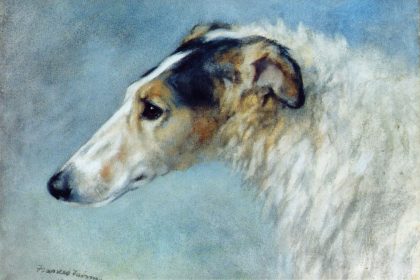
Every breed has idiosyncratic jargon familiar to people in the breed, but perhaps baffling to anyone outside of it. In the Borzoi, at least one term has to do with the coat that grows over certain parts of the dog. We’ve heard Borzoi-owning acquaintances call it a “butt wig,” and a “tush toupee,” and one highly educated owner we knew called it a “posterior postic.”
“It” refers to heavy hair growth over the hip area of a Borzoi. For whatever reason, hair has been known to grow the heaviest in a patch over the shoulders and over the hips and croup in this breed. While this doesn’t impact a dog’s ability to do his job, it might impact breed type when the coat fills in the graceful curve of the dog. It also can make the dog’s croup look flatter than it really is by making the hair over the croup look like someone blew air into the undercoat. Female Borzoi are marginally less prone to this than males, but in their case, hormonal changes can cause a bitch to blow coat causing a different challenge to the groomer facing a topline that has shed coat in the middle making a sound dog look swaybacked.
Trimming seems like it would be a logical solution were it not for the fact that trimming makes the coat feel coarse, particularly over a dog’s shoulders. We’ve also read that some colors, especially red and sable dogs, have pale roots but dark ends, and even the lightest hand can make the coat look worse.
Why?
Remember that Borzois have feathering on their hindquarters and a frill on their neck, key aspects of their outline. Trimming them can make the coat look less full and disrupt the natural elegance of the breed, especially if the coat color in these areas is lighter or has a different texture. We circle back to the “posterior postic,” which, for all intents and purposes, makes it look like a Borzoi is wearing a hairpiece on his or her rear end or shoulders.
So what is the solution? From a judge’s standpoint, it’s to not penalize an untrimmed dog, The AKC breed standard is pretty accommodating in allowing a generous range of coat types, with no preference given as long as it is “long and silky – not woolly,” and it can be flat, wavy, or somewhat curly (though curliness is less common than it used to be) – and most coats can be a combination of all three.
At the end of the day, however, a dog is more than its coat. This is an elegant breed built to course on mostly open terrain, and to that end, far more important is a dog’s courage, sound running gear, and a strong neck and pair of jaws.
Image: Watercolor painting by Frances C. Fairman (1836-1923)/Public domain
